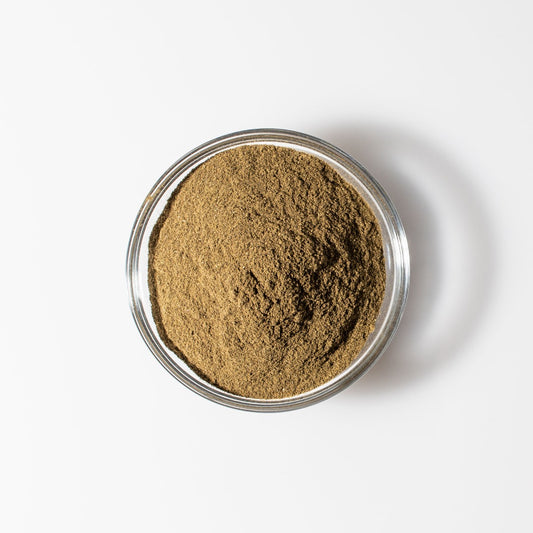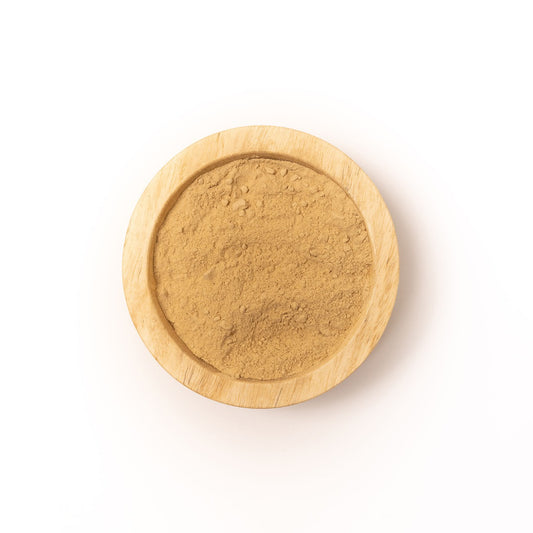Aah tulsi. Aromatic, delicious, beautiful, and sattvic, tulsi is one of those magical Ayurvedic herbs that can be enjoyed by just about everyone. Our corner of the world is currently emerging from the cold and gray of wintertime—what a perfect time to immerse ourselves in tulsi—an herb that offers to anoint us with its lightness, warmth, and clarity (yes, please!).
Before you begin reading, we highly recommend you first brew a soothing cup of tulsi tea to heighten our time together as we share the wonders of this beautiful herb, how to take it, and how it can brighten up your life.
Pull up a chair, get cozy with your tea, and join us as we tell the tales and sing the well-earned praises of this Queen of Herbs.
Reasons to Love Tulsi
There are so many things about this vibrant green plant to love—from the many benefits of tulsi, to its rich and fascinating history, to its breathtaking (or since it has an affinity for the lungs, breath-giving) beauty!
In appearance, the tulsi plant boasts lush purple blossoms that jut out from its verdant green leaves, not unlike the towers and turrets of an enchanted castle. Likewise enchanting is its smell—which some have described as minty, with hints of citrus and licorice.
With its striking appearance and enticing smell, it's no surprise that tulsi plants are often surrounded by bees, whose drones as they busily work to pollenate can provide a soothing tone that only makes the experience of walking through a tulsi field all the more magical.
At Banyan Farm, tulsi grows in abundance, and is regularly serenaded not only by bees, but by the Living Ayurveda Interns. On some evenings, interns can be found in the tulsi fields singing to the plants, practicing an Agnihotra ceremony, or having lively conversations in the presence of this majestic herb.
Given tulsi's history as a deeply spiritual plant that has been worshipped across cultures, it's no surprise that all of us at Banyan—interns and bees included—can't get enough of it.

Oh, Holy Basil! Spiritual Properties of Tulsi
Tulsi is also known by its Latin name, Ocimum sanctum, or by the name tulasi. However, there is one name it goes by that goes a long way to illustrate the place of reverence this plant holds around the world—the name “holy basil.”
Why is tulsi called holy basil? Well, the word “basil” derives from “basileus,” a Greek word that means “royal” or “king,”1 and common basil itself (Ocimum basilicum) is considered a spiritually significant plant in some cultures, having been used to make holy water and bless church altars in the Greek Orthodox religion and throughout Eastern Europe.2
“Sanctum,” or “holy,” is a reference to tulsi's spiritual significance across so many cultures—since this plant is so often associated with holiness around the world.
Tulsi in the East
Tulsi's presence is steeped within many ancient Indian myths, and some spiritual traditions consider tulsi to be the embodiment of the goddess Lakshmi, with her spiritual powers infused within the plant.3
Because of this belief, you could say that owning a tulsi plant is like caring for a living blessing that constantly purifies your home. It is no wonder tulsi is grown in many home courtyards throughout India, where it is offered gratitude and reverence as part of daily puja (worship). In fact, the lack of a tulsi plant in a courtyard is considered by some to give a feeling of emptiness and dullness in the home.4
Tulsi is also present in some big life transitions in Indian culture. Tulsi plays a huge role in kick-starting the wedding season across the country. Only after the completion of Tulsi Vivaha (the yearly ritual in which the tulsi plant is symbolically wed to Lord Vishnu) is it considered a good time to start planning a wedding.
Thanks to its purifying nature, tulsi is also present at a much different juncture—at the deathbed. By placing tulsi upon the dying person, it is said to help cleanse the soul and stop the cycle of death and rebirth.5
Tulsi in the West
Tulsi's recognition as a deeply spiritual herb goes beyond India's borders and is even rooted in some profound legends within Christianity. For example, tulsi is said to have greeted Christ's disciples at his tomb after his crucifixion—the tomb was empty, but the surrounding countryside was carpeted with blooming tulsi.
A few hundred years later, the mother of the Roman Emperor Constantine found a hill similarly covered in this aromatic plant. According to legend, hidden under this hill was the cross of Christ.
From these legends, tulsi became a Christian symbol of holiness and spiritual birth and is still used to this day in Christian rituals.6 For example, as a powerful purifier, it has a role in the Greek Orthodox tradition of preparing holy water.7
Tulsi in Ayurveda
Ayurveda certainly recognizes the sacred nature of tulsi. Its Sanskrit name translates as “the incomparable one.” This could be interpreted in several ways, but perhaps it simply means there are literally no comparisons or substitutions for this herb and what it has to offer.
After all, tulsi is high in sattva—the principle of light, perception, and clarity.
As a sattvic herb, tulsi infuses you with its divine energy—body, mind, and soul, in true Ayurvedic fashion.
This could explain its rather inspiring power to heighten awareness and mental clarity, as well as its unique ability to open the mind and heart to love and devotion. (We bet you're enjoying your tea on a whole new level now!)

Tulsi the Adaptogen
Tulsi is among a group of super-herbs known in Ayurveda known as adaptogens, or adaptogenic herbs. As an adaptogen, tulsi can help us cope with stress in a major way, protecting the organs and tissues from the negative effects of stress.8
It is also said to increase prana (life force) and support healthy digestion.
How to Incorporate Tulsi into Your Life
It goes without saying that tulsi is a pretty complex and amazing herb. But the ways in which you can use it—both internally and externally—can be surprisingly simple and easy to integrate into your day. Here are a few ideas on how to take tulsi and enjoy its incredible qualities.
-
Tulsi Tea. For a delicate and flavorful cup of tea that supports optimal well-being, sip on Tulsi Echinacea throughout the day. If you're experiencing a little excess kapha, add some honey to your tea. If you would like to increase the sattvic qualities and promote even more ojas, or if you have an excess of vata, add a little ghee.
- If you want to experience the versatility of this herb, here are a few more tea variations to try:
- Add fennel, and cardamom to your tea if you're working on digestive troubles due to excess vata. Drinking this blend before meals will warm and enkindle agni, your digestive fire.
- Add some brahmi/gotu kola and bacopa if you're looking to benefit your mind, support your nervous system, and tap into tulsi's ability to promote awareness and clarity.
- If you want to experience the versatility of this herb, here are a few more tea variations to try:
-
Tulsi for Immune and Respiratory Support. Here at Banyan, tulsi is a longtime favorite for when it's time to support our immune systems and tend to respiratory health. Here are a few ways to enjoy its immense health-boosting powers:
- Use tulsi powder and ginger powder to make a big pot of tea to sip throughout the day. This blend will gently and effectively jump-start a lagging, tired immune system that needs an extra boost.
- Our Immune Strong liquid extract and Immune Strong tablets feature tulsi, along with a variety of other powerful immune-boosting herbs, in easy-to-take forms.
- Our Lung Formula and Bronchial Support Herbal Syrup offer two ways to support the lungs and respiratory tract through the winter months and beyond.
-
Tulsi in Other Products. If you can't tell by now, we seriously love tulsi. It is incredibly versatile and effective, which is why we carry so many products that contain tulsi.
- Our Tulsi tablets provide a convenient and easy way to add tulsi to your day.
- Our Healthy Kapha tablets pair tulsi with other quintessential kapha-busting herbs to clear and manage excess kapha throughout the body.
- Using Daily Massage Oil, Vata Massage Oil, or Kapha Massage Oil is a great way to invite tulsi into your daily self-care practices through the practice of abhyanga.
- Breast Care Balm features tulsi's ability to support healthy circulation of blood and lymph and is a favorite way to support healthy breast tissue.
- Mood Support combines tulsi with mood-enhancing herbs, including saffron, rose, and beet, to soothe anxiousness, enhance mental outlook, and promote emotional well-being.
Lastly, if you're interested in growing your own tulsi garden at home, we offer four varieties of organic tulsi seeds that were grown and gathered at Banyan Farm in Southern Oregon.
Final Praises
Sattvic, ojas-full, adaptogenic, beautiful, and downright delicious, it's a bit of a mystery how one small herb has so much to offer.
There is absolutely no way we have encompassed the entirety of this herb in this one overview. We encourage you to make fast friends with tulsi and discover more about this powerful herbal ally on your own journey to well-being. As for us—well, we're off to make another pot of tulsi tea!







